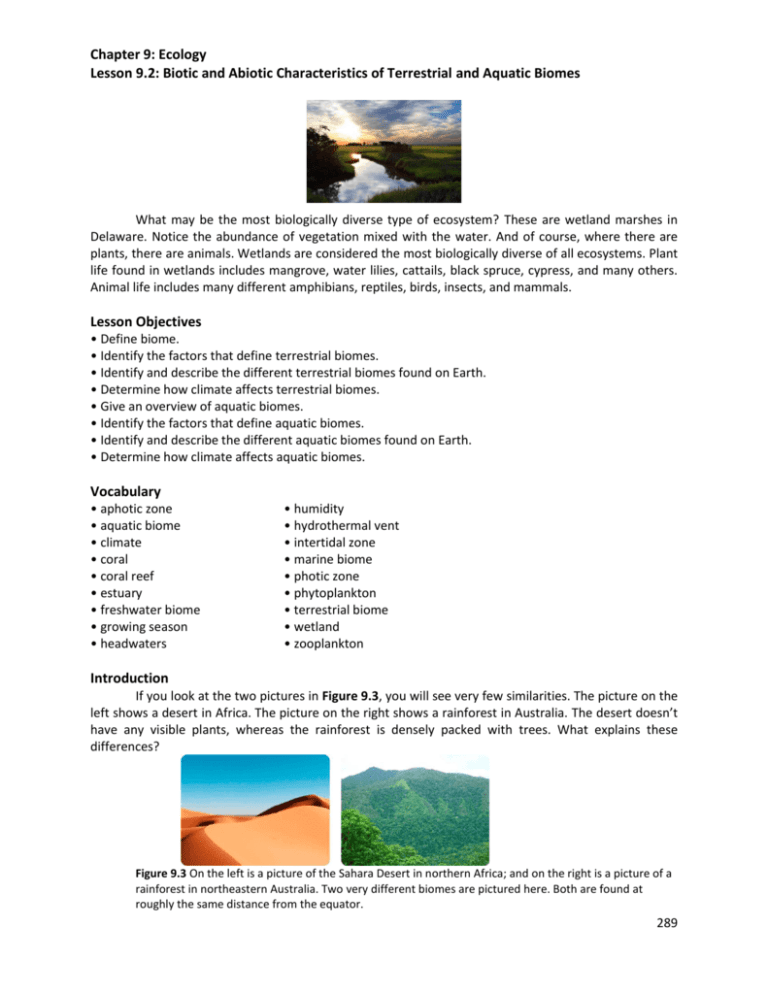Describe the Abiotic Factors That Determine a Terrestrial Biome
Some biomes such as temperate grasslands and temperate forests have distinct seasons with cold weather and hot weather alternating throughout the year. Correct answer to the question Describe the abiotic factors that determine a terrestrial biome.

Chapter 9 Ecology Lesson 9 2 Biotic And Abiotic Characteristics Of
Describe the abiotic factors that determine a terrestrial biome.

. Annual totals and fluctuations of precipitation affect the kinds of vegetation and animal life that can exist in broad geographical regions. 13 What is the definition of a biome quizlet. Temperature is a lot more constant in aquatic biomes than terrestrial biomes because of waters high heat capacity However warmer temperature and colder temperature can fluctuate in small ponds and lakes.
Oxygen is non polar water is polar. Abiotic factors could be all kinds of things. Latitude affects terrestrial biomes according to the angle at which the sunlight strikes Earth.
In a marine ecosystem abiotic factors would include salinity and ocean currents. Some biomes such as temperate grasslands and temperate forests have distinct seasons with cold weather and hot weather alternating throughout the year. 11 Which is important in determining the characteristics of biomes.
Biotic and abiotic are the two essential factors responsible for shaping the ecosystem. A terrestrial biome is a land biome vs an oceanlakestream biome. Abiotic component refer to any non living component in the ecosystem.
Abiotic factors are non-living factors that are crucial to the functioning of a terrestrial land biome. Temperature and precipitation and variations in both are key abiotic factors that shape the composition of animal and plant communities in terrestrial biomes. Some biomes such as temperate grasslands and temperate forests have distinct seasons with cold weather and hot weather alternating throughout the year.
Learn more about abiotic factors with this curated resource collection. The biotic factors refer to all the living beings present in an ecosystem and the abiotic factors refer to all the non-living components like physical conditions temperature pH humidity salinity sunlight etc and chemical agents different gases and mineral nutrients. The abiotic factors such as the amount of rainfall and the temperature are going to influence other abiotic factors such.
Describe the abiotic factors that determine a terrestrial biome. The solubility of oxygen in water is low and decreases with increasing temperature. Two major abiotic factors that determine terrestrial biomes are climate and latitude.
Wind temperature rainfall ground water humidity amount of sunlight soil composition intensity of daylight air pollution noise. Describe the abiotic factors that determine a terrestrial biome. The measure of the average energy of motion or kinetic energy of particles in matter or simply the measurement of hotness and coldness.
Some biomes such as temperate grasslands and temperate forests have distinct seasons with cold and hot weather alternating throughout the year. Abiotic and biotic factors work together to create a unique ecosystem. 9 What are the two factors that determine the boundaries of a biome.
Terrestrial biomes which are land-based such as deserts and forests. Biotic components of the ecosystem refer to any living component and their interactions. Describe the abiotic factors that determine a terrestrial.
12 Do biomes contain two ecosystems. A biome is determined by the temperature in C of a location. Temperature and precipitation and variations in both are key abiotic factors that shape the composition of animal and plant communities in terrestrial biomes.
Some examples of abiotic factors include-- oxygen availability sunlight water minerals. Temperature and precipitation and variations in both are key abiotic factors that shape the composition of animal and plant communities in terrestrial biomes. Climate is determined by latitude elevation ocean currents and other abiotic factors.
The eight major terrestrial biomes on Earth are each distinguished by characteristic temperatures and amount of precipitation. Abiotic factors could be all kinds of things. 10 What is the defining characteristic of a terrestrial biome.
Describe the abiotic factors that determine a terrestrial biome. In a terrestrial ecosystem examples might include temperature light and water. Wind temperature rainfall ground water humidity amount of sunlight soil composition intensity of daylight air pollution noise pollution etc.
Temperature and precipitation and variations in both are key abiotic factors that shape the composition of animal and plant communities in terrestrial biomes. Aquatic biomes which are water-based such as ponds and lakes. 1 Show answers Another question on Biology.

Biomes What Is A Biome What Is A Biome A Large Area With Similar Climate And Soil Conditions A Large Area With Similar Climate Biomes Free Math Ecosystems

Terrestrial Biomes Ch 6 Sev2 C Characterize The Components That Define A Biome Abiotic Factors To Include Precipitation Temperature And Soils Biotic Ppt Download


Comments
Post a Comment